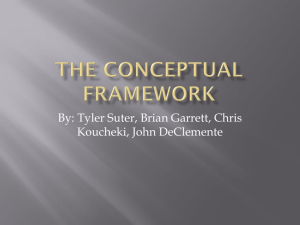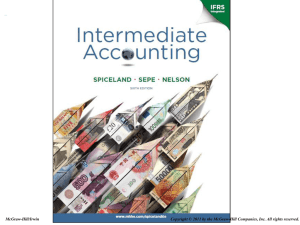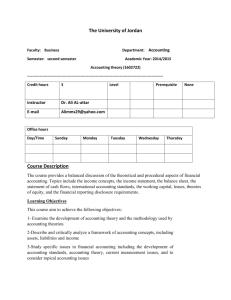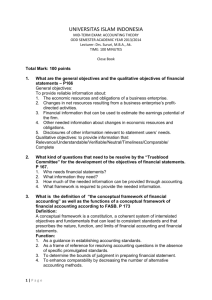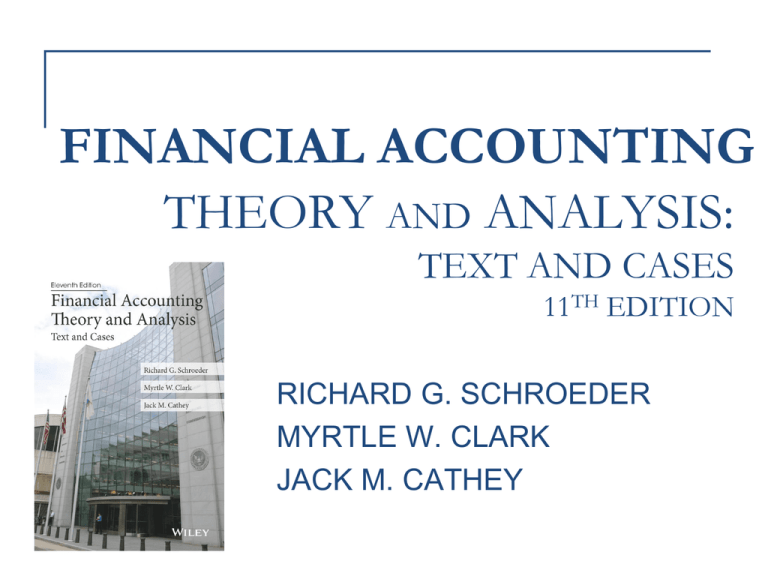
FINANCIAL ACCOUNTING
THEORY AND ANALYSIS:
TEXT AND CASES
11TH EDITION
RICHARD G. SCHROEDER
MYRTLE W. CLARK
JACK M. CATHEY
Chapter 2
The Pursuit of the
Conceptual Framework
Introduction
What is the conceptual framework?
An attempt by the FASB to develop concepts useful in guiding the Board in
establishing standards and in providing a frame of reference for resolving
accounting issues
The Early Theorists
Paton
All changes in the value of assets and liabilities should be
reflected in the financial statements, and that such changes
should be measured on a current value basis. Also, basic
assumptions or postulates underlying the accounting process
Canning
Suggested a framework for asset valuations and
measurement based on future expectations as well as a
model to match revenues and expenses.
Introduction
DR Scott and his conceptual framework
Was viewed as an outsider; however, his writings have proven to
be quite insightful.
Heavily influenced by the views of his colleague, the economist
and philosopher Thorstein Veblen.
Believed the industrial revolution caused managers to look for
new methods of maintaining organizational control. As a result,
scientific methods such as accounting and statistics became
organizational control tools.
Need for a normative theory of accounting
The Basis for Accounting Principles
Orientation Postulate
Accounting is based on a broad consideration of the current
social, political, and economic environment.
The Pervasive Principle of Justice
The second level in Scott’s conceptual framework was justice, which was
seen as developing accounting rules that offer equitable treatment to all
users of financial statements.
The Principles of Truth and Fairness
Truth was seen as an accurate portrayal of the information presented.
Fairness was viewed as containing the attributes of objectivity, freedom
from bias, and impartiality.
The Principles of Adaptability and Consistency
Adaptability was viewed as necessary because society and economic
conditions change; consequently, accounting must also change. However,
need to balance adaptability with consistency by stating that accounting
rules should not be changed to serve the temporary purposes of
management.
Ahead of his time
Early Authoritative and Semi-authoritative
Organizational Attempts to Develop the Conceptual
Framework of Accounting
Goal was to provide guidance to
the SEC.
Widely criticized by academics
as relying too heavily on the
historic cost model and the
convention of conservatism.
Highlighted the distinction
between the current operating
performance and all-inclusive
concepts of income.
Early Authoritative and Semi-authoritative
Organizational Attempts to Develop the Conceptual
Framework of Accounting
Goal was to provide
guidance to the SEC on the
best accounting practices
Study did not accomplish its
objective because it was
viewed as a defense of
accepted practices rather
than an attempt to develop
a theory of accounting
Early Authoritative and Semi-authoritative
Organizational Attempts to Develop the Conceptual
Framework of Accounting
AAA benchmark study by Paton
and A. C. Littleton.
Continued to embrace the use of
historical cost.
Major contribution was the further
articulation of the entity theory.
Also described the matching
concept.
Later cited as developing a
theory that has been used in
many subsequent authoritative
pronouncements
The CAP and the Conceptual Framework
Standard-setting bodies initially
reluctant to deal with the issue of
accounting theory.
At its inception, the Committee on
Accounting Procedure (CAP) had
considered developing a
comprehensive set of accounting
principles.
Dropped the idea because of the belief that the
SEC might not be patient enough to allow the
CAP enough time to develop the project and, as a
consequence, might decide to develop its own
accounting standards.
The CAP and the Conceptual Framework
The Special Committee on Research
Programs established to review and
make recommendations on the
AICPA’s role in establishing
accounting principles.
Proposed the establishment of the Accounting
Principles Board (APB) to replace the CAP.
Also proposed the establishment of a research
division to assist the APB.
The APB and the Conceptual Framework
Committee’s first charge to the APB’s
research division was to commission studies
on the postulates and principles that would
serve as the foundation for future
authoritative pronouncements.
This can be viewed as the first real attempt to establish a
conceptual framework of accounting by an authoritative body.
The AICPA accepted the committee’s recommendations
and in 1959, the APB replaced the CAP.
Postulates study
Research study
ARS No. 1 (1961)
The Basic Postulates of Accounting
Hierarchy of postulates
Group A: Economic and Political
Based on the economic and political environment in which accounting
exists.
Represent descriptions of those aspects of the environment were
presumed to be relevant for accounting
Group B: Accounting
Focuses on the field of accounting.
Designed to act as a foundation and assist in constructing
accounting principles.
Group C: Imperatives
Differs fundamentally from the first two groups.
Not primarily descriptive statements; instead, they represent a set of
normative statements of what should be rather than statements of what is.
Disastrous outcome
Early Authoritative and Semi-authoritative
Organizational Attempts to Develop the Conceptual
Framework of Accounting
ARS
No. 3
1962
Use of current
values
Departure
from SEC’s
advocacy
of
historical
cost
APB
Statement
No. 4
Definition of
accounting
Sophistication of
users
Description of
current practice
Not GAAP
ASOBAT
1966
Information
system involving
communication
Economic income
Decision
Usefulness
Standards for evaluating: relevance,
verifiability, freedom from bias,
quantifiability
The Trueblood Committee
1. Who needs financial
statements?
2. What information do they
need?
3. How much of the needed
information can be provided by
accountants?
4. What framework is needed to
provide the needed
information?
The Trueblood Committee
1.
2.
3.
4.
Committee report specified the following
four information needs of users:
Making decisions concerning the use of limited resources
Effectively directing and controlling organizations
Maintaining and reporting on the custodianship of resources
Facilitating social functions and controls
Objectives of financial reporting
Difficulty in finding agreement and therefore answers
Viewed as first step
Statement on Accounting Theory and
Theory Acceptance
Rationale for the committee’s approach
The approaches to accounting theory were
condensed into
1.
2.
Fundamental changes since ASOBAT
No one theory exists
Classical-deductive and disconnected
Decision Usefulness-usefulness is a basic
objective
3. Information Economics- specify information
necessary to make economic decisions
Criticisms of the approaches to theory
Statement on Accounting Theory
and Theory Acceptance
Committee suggested that the process of theorizing in accounting was more
revolutionary than evolutionary and turned to a perspective developed by
Kuhn.
He suggests scientific progress proceeds in the following order:
1. Acceptance of a paradigm
2. Working with that paradigm by doing normal science
3. Becoming dissatisfied with that paradigm
4. Searching for a new paradigm
5. Accepting a new paradigm
SATTA suggested that accounting theory at that time was in step 3 of this
process because a number of theorists had become dissatisfied with the
matching approach to specifying the content of financial reports.
The FASB’s Conceptual Framework
Project
The objectives identify the goals
and purposes of financial
accounting; whereas, the fundamentals are the
underlying concepts that help achieve those objectives.
These concepts are designed to provide guidance in:
1.
2.
3.
Selecting the transactions, events and circumstances to be
accounted for
Determining how the selected transactions, events, and
transactions should be measured
Determining how to summarize and report the results of events,
transactions and circumstances.
The Conceptual Framework
The FASB originally developed six SFACs
In 2010 SFAC No’s 1 & 2 were replaced by
SFAC No. 8
Figure 2.1 provides an overview of the
FASB's conceptual framework for financial
accounting and reporting.
The Conceptual Framework for Financial Accounting and Reporting
OBJECTIVE
SFAC No. 8
OBJECTIVES
ELEMENTS
QUALITATIVE
CHARACTERISTICS
SFAC No. 6
FUNDAMENTALS
Revenue
Expense
Gain
Loss
Asset
Liability
Equity
SFAC No’s. 5 & 8
Relevance
Faithful
Representation
RECOGNITION, MEASUREMENT AND DISCLOSURE CONCEPTS
IMPLEMENTATION
GUIDELINES
ASSUMPTIONS
Economic
Entity
Going Concern
Monetary Unit
Periodicity
PRINCIPLES
Measurement
Revenue Recognition
Expense Recognition
Full Disclosure
CONSTRAINTS
Cost
Industry
Practices
Conceptual Framework
Level 3: identifies the implementation guidelines of recognition,
measurement, and disclosure used in establishing and applying
accounting standards and the specific concepts to put into practice
the objective. These guidelines include the assumptions, principles,
and constraints that describe the present reporting environment.
Level 2: outlines the fundamentals which are the qualitative
characteristics that make accounting information useful and the
elements of financial statements (assets, liabilities, etc.)
Level 1: identifies the objective of financial reporting—that is, the
purpose of financial reporting.
Statement of Financial Accounting Standards No. 8
Chapter 1
Objective of general‐purpose financial
reporting
Provide financial information about the reporting
entity that is useful to present and potential equity
investors, lenders, and other creditors in making
decisions about providing resources to the entity.
Decisions involve buying, selling, or holding equity
and debt instruments, and providing or settling loans
and other forms of credit.
Information that is decision‐useful to capital
providers may also be useful to other users of
financial reporting, who are not capital providers.
Statement of Financial Accounting Standards No. 8
Criticism
Young criticized FASB’s viewpoint
that financial statement users are
“rational decision-makers”
Other types of information that might
be useful to other groups are omitted
Accounting standard-setters fail to
contact actual users of information
Statement of Financial Accounting Standards No. 8
Chapter 1
The objective of financial reporting is
foundation of the conceptual framework.
Other aspects of the framework—qualitative
characteristics, elements of financial statements,
recognition, measurement, and disclosure—flow
logically from the objective.
Those aspects of the framework help to ensure
that financial reporting achieves its objective.
Statement of Financial Accounting Standards No. 8
Chapter 1
The second level of the CFP contains the
fundamental concepts.
Provide
Conceptual building blocks
Include the qualitative characteristics
of accounting information and the
elements of financial statements.
Statement of Financial Accounting Standards No. 8
Chapter 3
Identifies the qualitative characteristics of
accounting information that distinguish better
(more useful) information from inferior (less
useful) information for decision‐making
purposes.
These characteristics may be
viewed as a hierarchy
Capital Providers
(Investors and Creditors) and
their characteristics
Primary Users of Accounting
Information
Pervasive Constraint
Fundamental qualities
Ingredients of
Fundamental
qualities
Cost
Relevance
Predictive
value
Faithful Representation
Materiality
Confirmatory
value
Enhancing
qualities
Comparability
Verifiability
Completeness
Free
from
error
Neutrality
Timeliness
Understandability
Primary Users of Financial
Information
Existing or potential investors, lenders and
other creditors
Its capital providers
SFAS No. 8: Cost Constraint
Cost is described as a pervasive constraint
on the information that can be provided by
financial reporting.
The measurement, summarization, and reporting
of financial information imposes costs, and it is
important that those costs are justified by the
benefits of reporting that information.
SFAS No. 8: Cost Constraint
This type of analysis is made on several levels.
Companies must decide whether the benefits of
providing financial information outweigh the
costs involved in collecting, processing,
verifying, and disseminating that information.
Users of financial information must decide whether the
benefits of analyzing and interpreting the information
provided outweigh their costs.
Regulators must assess whether the benefits of
reporting particular information are likely to justify the
costs incurred to provide and use that information.
This is termed cost-benefit analysis
SFAS No. 8: Qualitative Characteristics
Distinguishing between better (more useful)
information from inferior (less useful)
information.
These qualitative characteristics
Either fundamental or enhancing characteristics
Depending on how they affect the decision‐usefulness
of information.
The two fundamental qualities that make
accounting information useful for
decision‐making
1. relevance and
2. faithful representation.
SFAS No. 8: Relevance
Relevant financial information is capable of
making a difference in the decisions made by
users.
Financial information is capable of making a
difference in decisions if it has:
Predictive value: it can be used as an input to
processes employed by users to predict future
outcomes.
Confirmatory value: it provides feedback (confirms or
changes) about previous evaluations.
Materiality: if omitting it or misstating it could influence
decisions that users make on the basis of the financial
information of a specific reporting entity.
SFAS No. 8: Faithful Representation
Financial reports represent economic
phenomena in words and numbers.
To be useful, financial information
Must represent relevant phenomena
Must faithfully represent the phenomena that it purports to
represent.
A perfectly faithful representation has three
characteristics:
1.
2.
3.
Completeness
Neutrality
Free from error.
SFAS No. 8: Faithful Representation
A complete depiction should include all
information necessary for a user to understand the
phenomenon being depicted.
A neutral depiction
Without bias in the selection or presentation of
financial information.
Not slanted, weighted, emphasized,
deemphasized, or otherwise manipulated to
increase the probability that financial information
will be received favorably or unfavorably by users.
Free from error
There are no errors or omissions in the description of the
phenomenon
Process used to produce the reported information has been
selected and applied with no errors in the process.
Information that is free from error will result in a more faithful
representation of financial results.
SFAS No. 8: Enhancing Qualities
Qualitative characteristics enhance the usefulness of
information that is relevant and faithfully represented.
Comparability is the qualitative characteristic that enables users
to identify and understand similarities in, and differences among,
items.
Verifiability helps assure users that information faithfully
represents the economic phenomena it purports to represent.
Different knowledgeable and independent observers could reach
consensus, although not necessarily complete agreement
A particular depiction is a faithful representation.
Timeliness means having information available to decision
makers in time to be capable of influencing their decisions.
Understandability involves classifying, characterizing, and
presenting information clearly and concisely.
Additional Phases
Three additional phases of the CPF are currently
inactive
1.
2.
3.
The reporting entity
Measurement
Elements and recognition phases.
The FASB has determined that because of the
priority placed on other projects, it cannot devote the
time necessary to properly address those issues in
the near future.
May, 2012: The IASB announced that it will resume
deliberations on the CFP as an IASB-run project,
that is, no longer a joint project with the FASB.
No. 5 “Recognition and Measurement in
Financial Statements of Business
Enterprises”
Sets forth recognition criteria and
guidance on what information should be incorporated
into financial statements and when this information
should be reported
Defined comprehensive income as:
Revenues
Less: Expenses
Plus: Gains
Less: Losses
= Earnings
Earnings
Plus or minus cumulative
accounting adjustments
Plus or minus other
non-owner changes in equity
= Comprehensive Income
No. 5 “Recognition and Measurement
in Financial Statements of Business
Enterprises”
Measurement Issues
1.
Definitions.
2.
The item meets the definition of an element contained in
SFAC No. 6.
Measurability.
3.
It has a relevant attribute measurable with sufficient
reliability.
Relevance.
4.
The information about the item is capable of making a
difference in user decisions.
Reliability.
The information is representationally faithful, verifiable, and
neutral.
SFAC No. 5 Gaps
Failure to define “earnings”
No resolution on debate of current value vs
historical cost
No. 6 “The Elements of Financial
Statements”
Defines the ten elements of financial
statements that are used to measure the
performance and position of economic
entities
These elements are discussed
in more depth in Chapters 5
and 6.
SFAC No. 7 “Using Cash Flow Information and
Present Value in Accounting Measurements”
Accounting measurement is a very broad topic.
Consequently, the FASB focused on a series of questions relevant to
measurement and amortization conventions that employ present
value techniques. Among these questions are:
What are the objectives of using present value in the initial recognition of
assets and liabilities? And, do these objectives differ in subsequent
fresh-start measurements of assets and liabilities?
Does the measurement of liabilities at present value differ from the
measurement of assets?
How should the estimates of cash flows and interest rates be
developed?
What are the objectives of present value when used in conjunction with
the amortization of assets and liabilities?
How should present value amortizations be used when the estimates of
cash flows change?
SFAC No. 7 “Using Cash Flow Information and
Present Value in Accounting Measurements”
Purpose is to capture economic difference between sets of future cash flows.
Present value measurements that fully captures the economic differences
between assets should include the following elements:
1.
An estimate of the future cash flows
2.
Expectations about variations in the timing of those cash flows
3.
The time value of money represented by the riskfree rate of interest
4.
The price for bearing the uncertainty
5.
Other, sometimes unidentifiable, factors including illiquidity and
market imperfections
SFAC No. 7 “Using Cash Flow Information and
Present Value in Accounting Measurements”
Approaches to present value
1.
2.
Traditional-Single cash flow single interest
rate
Expected cash flow range
Incorporating probabilities
The objective is to estimate the value of the assets
required currently to settle the liability with the holder
or transfer the liability to an entity with a comparable
credit standing
Use of the interest method
Principles Based vs. Rules Based
Accounting Standards
Continuum ranging from
highly rigid standards on one end
to general definitions of economics-based concepts on
the other end.
Example: Goodwill
Previous practice:
Goodwill is to be amortized over a 40 life until it is fully amortized.
New FASB rule:
Goodwill is not amortized.
Any recorded goodwill is to be tested for impairment and written
down to its current fair value on an annual basis.
Principles-Based
Better able to cope
with speed of change of
business environment
Less Voluminous
Encourages use of
professional judgment
with focus on what is
right
Seen as possibly
discouraging financial
engineering
Rules-Based
More workable in large,
complex economies &
countries
Less room for
interpretation
Provides more guidance
for practical
implementation
Less need for
explanation in financial
statements
FASB Questions
1.
Do you support the Board’s proposal for a principles-based approach to U. S. standard
setting?
Will that approach improve the quality and transparency of U. S. financial accounting and
reporting?
2.
Should the Board develop an overall reporting framework as in IAS 1?
If so, should that framework include a true and fair override?
3.
Under what circumstances should interpretive and implementation guidance be
provided under a principles-based approach to U.S. standard setting?
Should the Board be the primary standard setter responsible for providing that guidance?
4.
Will preparers, auditors, the SEC, investors, creditors, and other users of financial
information be able to adjust to a principles-based approach to U.S. standard setting?
If not, what needs to be done and by whom?
5.
6.
What other factors should the Board consider in assessing the extent to which it should
adopt a principles-based approach to U.S. standard setting?
What are the benefits and costs (including transition costs) of adopting a principlesbased approach to U.S. standard setting?
How might those benefits and costs be quantified?
Principles Based vs. Rules Based
Accounting Standards
The AAA’s position
Wrong question
Economic substance, not form
Dissenting opinion
US standards also include rules-based elements
Further developments
2003 SEC study submitted to Congress
Included recommendations to FASB
2004 FASB response to recommendations
1.
2.
3.
4.
5.
6.
Issuing Objectives-Oriented Standards
Conceptual Framework
One U.S. Standard Setter
GAAP Hierarchy
Access to Authoritative Literature
Comprehensive Review of Literature
International Convergence
Norwalk Agreement
September 18, 2002 FASB & IASB
pledged
Achieve compatibility
Maintain compatibility
3 Major aspects:
1. Financial Statements Presentation Project
2. Conceptual Framework Project
3. Standards Update Project
FASB-IASB Financial Statement
Presentation Project
Establish common standard
Goals
Understand past and present financial position
Understand changes and causes of changes
Evaluate future cash flows
FASB-IASB Financial Statement
Presentation Project
3 Phases
A. What constitutes complete set of statements?
B. Fundamental issues for presentation of
information
C. Presentation of interim financial information in
U.S. GAAP
Further Developments
February 2006 Memorandum of
Understanding (MOU)
Shared objective: develop high-quality, common
accounting standards
“Road map” for elimination of reconciliation
requirements
Develop new common standards rather than
eliminate differences
Convergence
1. Boards to reach conclusion on major
differences in focused areas
• 2008 goal
2. FASB & IASB seek to make continued progress
in other areas
November 2009 Progress Report
Milestone targets for each project
Commitment to reporting quarterly on
progress
Make reports available on web
Host monthly joint board meetings
FASB & IFRS Statements
4 New SFASs
SFAS No. 151 (Superseded)
SFAS No. 153 (Superseded)
SFAS No. 154
SFAS No. 163
SFAS No. 141 revised
IASB new standards on borrowing costs &
segment reporting
Phase B principles
Financial statement presentation
1. Cohesive financial picture
2. Financing activities separated
3. Liquidity of assets & liabilities
4. Disaggregate line items
5. Understand
Measurement of assets & liabilities
Uncertainty & subjectivity
Causes of changes in assets & liabilities
Financial Statements
Comprehensive Income
Financial Position
Cash Flows
Each statement to contain 2 primary section:
1. Business
Operating
Investing
2. Financing
Debt
Equity
Conceptual Framework Project
8 phases
1. Objectives and qualitative characteristics
2. Definitions of elements, recognition and
derecognition
3. Measurement
4. Reporting entity concept
5. Boundaries of financial reporting, and
presentation and disclosure
6. Purpose and status of framework
7. Application of framework to not-for-profit entities
8. Remaining issues, if any
End of Chapter 2
Prepared by Kathryn Yarbrough, MBA
Copyright © 2014 John Wiley & Sons, Inc. All rights reserved.
Reproduction or translation of this work beyond that permitted in
Section 117 of the 1976 United States Copyright Act without the
express written consent of the copyright owner is unlawful. Request
for further information should be addressed to the Permissions
Department, John Wiley & Sons, Inc. The purchaser may make backup copies for his/her own use only and not for distribution or
resale. The Publisher assumes no responsibility for errors,
omissions, or damages, caused by the use of these programs or from
the use of the information contained herein.

